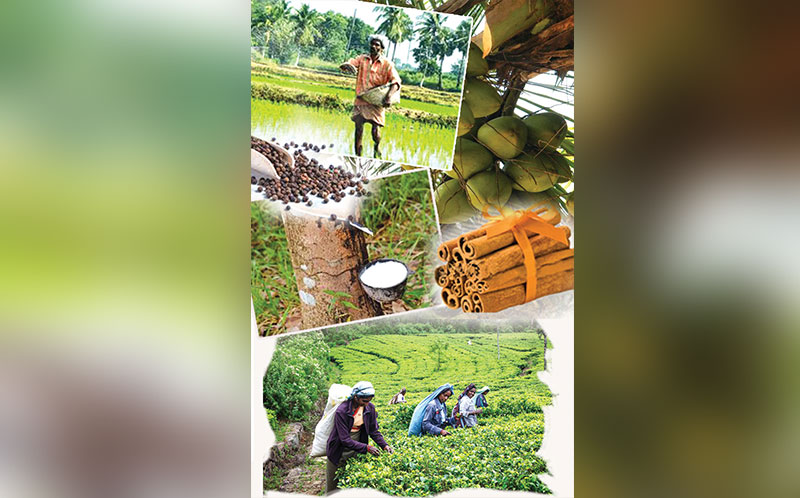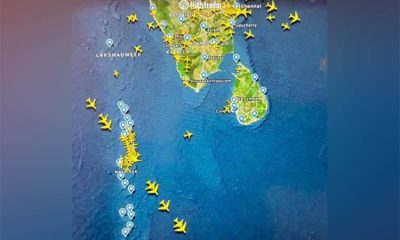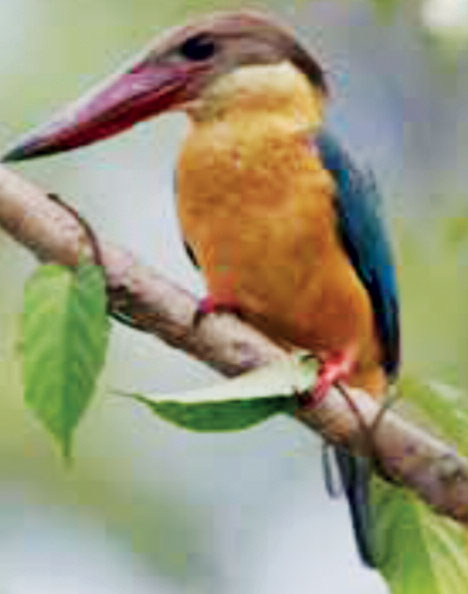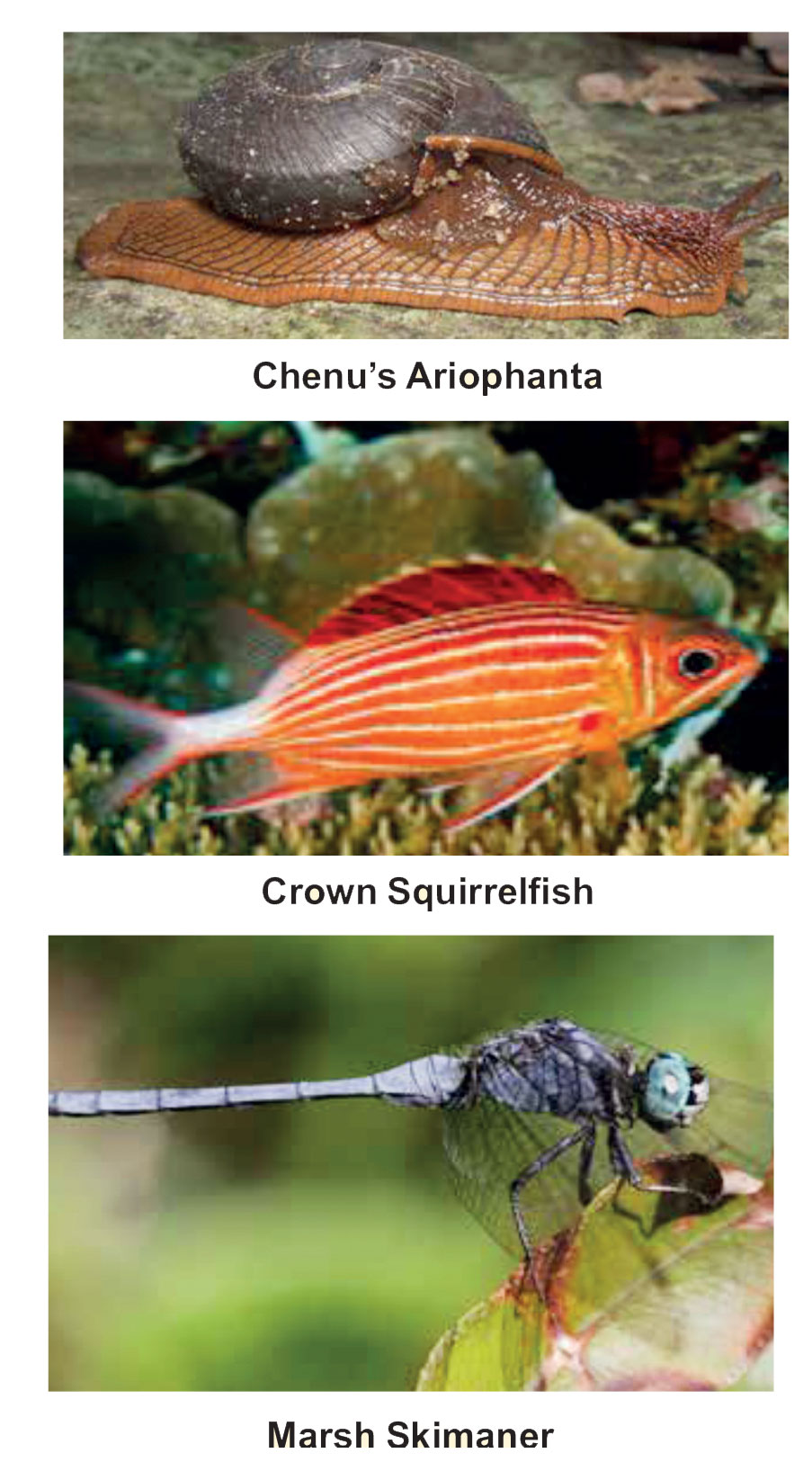Features
Navigating Climate Change: Urgent need for sustainable solutions in Sri Lanka

by Amarasiri de Silva
(International Day for Disaster Risk Reduction was observed on October 13.)
As a child, I found great comfort in the rhythmic sound of raindrops falling on the roof of our house during the monsoon months. The steady drumming of rain lulled me to sleep, and the cool, refreshing nights brought a sense of peace. The rain was a predictable companion, arriving on schedule and nourishing the earth. Back then, I developed a deep appreciation for the monsoon rains, its rhythm, and the life it brought to the land.
However, the patterns I grew up with have completely changed. What was once a soothing and life-giving force has become a symbol of unpredictability and destruction. People no longer welcome the rain with the same sense of comfort or security. Now, we are faced with devastating floods that erode the land, destroy homes, and sweep away carefully cultivated crops. These floods no longer follow the seasonal monsoon cycle; they happen throughout the year, with little warning or consistency.
News reports are now filled with images of flooding. We hear constant stories of entire communities being inundated, homes submerged, and people displaced. The once predictable and calming rain has become a source of anxiety and fear for many, as they brace themselves for its unpredictable wrath. The rhythm of raindrops on the roof has been replaced by the harsh reality of climate change and its far-reaching impacts on our lives. We hear new concepts like atmospheric rivers which we did not hear before they are a key part of the global water cycle and can often have hazardous effects.
As an island nation, we Sri Lankans are particularly vulnerable to the devastating effects of climate change, more so than many non-island nations. Its geographical position exposes it to rising sea levels, increasing temperatures, unpredictable weather patterns, and natural disasters, all of which are being intensified by global climate change. The island’s vulnerability is further heightened by its reliance on a land-based economy, with agriculture forming the backbone of livelihoods for many communities across the country. As a result, climate change poses a profound threat to the economic stability, food security, and well-being of the Sri Lankan population.
Sri Lanka’s agricultural sector, which employs a significant portion of the population and contributes considerably to the national economy, is particularly sensitive to climatic shifts. Agriculture in the country is heavily dependent on monsoonal rainfall, which has become increasingly erratic due to climate change. The once predictable seasonal patterns are being disrupted, leading to periods of intense drought followed by extreme rainfall, both of which are detrimental to crop production. Major crops such as rice, tea, and rubber are at risk of reduced yields, which would not only impact the livelihoods of farmers but also the nation’s food supply and export revenues.
The rural communities that rely on subsistence farming are especially at risk. Many of these communities are located in areas prone to flooding or drought, and they lack the resources to adapt to these rapidly changing conditions. Prolonged droughts threaten water availability for irrigation, while extreme rainfall can cause soil erosion and flooding, destroying crops. Additionally, increasing temperatures may push certain crops, such as tea, past their tolerance thresholds, further exacerbating economic hardship.
Coastal communities are also at the frontline of climate change. Rising sea levels, coupled with more frequent and intense storms, threaten to inundate low-lying areas, displacing populations and destroying infrastructure. Fishermen, who rely on coastal ecosystems for their livelihoods, are facing declining fish stocks due to warming ocean temperatures and coral reef degradation. These combined challenges further strain local economies, leading to potential migration crises and social unrest sometimes reflected as ethnic unrest as communities are forced to relocate or adapt to dwindling resources.
Given these looming threats, the Sri Lankan government must take decisive and proactive measures to mitigate the effects of climate change. It is critical that the government recognizes the gravity of the situation and develops comprehensive, long-term strategies to protect the country’s most vulnerable communities and industries. A multi-faceted approach is needed, combining climate-resilient agricultural practices, infrastructure improvements, and community education on adaptive strategies.
Investments in sustainable farming methods, such as drought-resistant crops, rainwater harvesting systems, and efficient irrigation technologies, can help safeguard agricultural production. Furthermore, improving early warning systems and disaster preparedness can help mitigate the impact of extreme weather events on both rural and coastal communities. Equally important in the fight against climate change is the protection and restoration of natural ecosystems such as mangroves and coral reefs. These ecosystems play a crucial role in acting as natural buffers against storms, coastal erosion, and rising sea levels. Mangroves, in particular, serve as a protective barrier along coastlines, absorbing the impact of waves and reducing the intensity of flooding during storms. Coral reefs also play a significant role by providing habitats for marine life and protecting shores from the full force of ocean waves.
It is disheartening, however, to witness the large-scale destruction of these vital ecosystems. Mangroves, like those in Muthurajawela, are being cleared out, often for short-term economic gain, without a clear understanding of the critical role they play in safeguarding coastal communities. The lack of awareness about the ecological importance of mangroves leads to their removal, which in turn increases the vulnerability of coastal areas to the impacts of climate change. This destruction not only exacerbates flooding and coastal erosion but also threatens biodiversity and the livelihoods of those dependent on these ecosystems.
As an island nation with a land-based economy, Sri Lanka is particularly susceptible to the compounded effects of both natural and man-made disasters. Deforestation, particularly the clearing of jungles, like Singha Raja is a major man-made contributor to the intensification of climate change. The widespread clearing of forests for agriculture, development, or other purposes reduces the land’s ability to absorb carbon dioxide, accelerates soil erosion, and disrupts water cycles. This exacerbates the frequency and intensity of climate-related events, such as floods and droughts, which have devastating consequences for the country’s agricultural productivity and overall stability.
The government must act swiftly to address these challenges by implementing forward-thinking policies that enhance the resilience of the country’s agricultural sector and protect its coastal regions. By doing so, Sri Lanka can reduce the potential economic and social disruptions caused by climate change and ensure a sustainable future for its people.
As the world continues to grapple with the reality of climate change, it becomes increasingly evident that the experience of global warming is not uniform across regions. Many characteristics of climate change are directly linked to the level of global warming, but the impacts that individuals and communities face vary significantly from global averages. For instance, warming over land is higher than the global average, and in certain regions like the Arctic, temperatures are rising at more than twice the global rate. These regional disparities highlight a key issue: while climate change is a global phenomenon, its effects are felt locally and often disproportionately.
The Intergovernmental Panel on Climate Change (IPCC) has long emphasized that climate change is already affecting every region on Earth in multiple ways. As Panmao Zhai, Co-Chair of the IPCC Working Group I, pointed out, “The changes we experience will increase with additional warming.” This statement underscores the fact that the consequences of climate change are not static; rather, they will intensify as global temperatures continue to rise. These changes are already reshaping ecosystems, economies, and societies around the globe, and their impacts are expected to become even more severe in the coming decades.
The IPCC’s latest report projects that climate changes will increase in all regions. At 1.5°C of global warming, we can expect to see a rise in the frequency and severity of heat waves, longer warm seasons, and shorter cold seasons. These changes may seem minor in isolation, but collectively, they represent a profound shift in the Earth’s climate systems. For instance, longer warm seasons and more frequent heat waves can lead to increased evaporation, drying up water sources that are critical for agriculture and human consumption. This, in turn, has far-reaching implications for food security, public health, and economic stability. At 2°C of global warming, the situation becomes even more precarious. Heat extremes will more frequently exceed the critical tolerance levels for both agriculture and human health. For farmers, this means that crops will struggle to survive in the face of extreme heat, fast spreading of weeds, fungi and pests, potentially leading to widespread food shortages. Similarly, human health will be compromised as higher temperatures contribute to heat-related illnesses, exacerbate existing health conditions, and place additional stress on healthcare systems, particularly with the growing incidence of mosquito-borne diseases. The risk to both agricultural sustainability and human well-being increases exponentially as the planet warms, highlighting the urgency of mitigating climate change.
However, the conversation about climate change cannot be limited to rising temperatures alone. Another critical issue that deserves attention is the widespread use of chemicals in agriculture. With the advent of the Green Revolution after 1964, Sri Lanka underwent a significant transformation in its ecosystem, particularly affecting aquatic systems. The push for high-yield agricultural practices during this period dramatically altered traditional farming methods and, in the process, disrupted delicate ecological balances.
As a child, I recall seeing tiny species of singing birds, such as sparrows, which were once a common sight. However, as I grew older and entered adulthood, these birds seemed to disappear from our villages. Similarly, the vibrant populations of small fish, like Thiththya, Dandi, and Bulath Hapaya, which once thrived in the streams winding through paddy fields, have all but vanished. These changes were not coincidental but were directly tied to the shifts in agricultural practices driven by the government’s focus on increasing food production, particularly rice.
To meet the growing demands of an expanding population, the government aimed to create a paddy economy that favored monocrop farming, replacing traditional subsistence farming systems. In the past, farmers cultivated a variety of crops, including vegetables, tree crops, and traditional rice varieties, providing diversity in both food supply and agricultural practices. However, the new paddy economy centered on high-yield rice varieties that required intensive cultivation methods, drastically altering traditional farming landscapes.
The introduction of these high-yield varieties necessitated the extensive use of chemical fertilizers to boost production, alongside weedicides to control weeds and pesticides to combat pests. These chemicals, while essential for sustaining the new farming model, brought with them a range of unintended and harmful consequences. One of the most alarming effects has been the pollution of shallow well water, which had served as the primary source of drinking water in many rural villages for centuries. The contamination of water sources with chemical residues has not only damaged the local ecosystems but also posed severe health risks to local populations.
The consumption of polluted water has led to a rise in health issues, particularly chronic kidney disease, in the dry zone districts of Sri Lanka. This health crisis has become a significant concern not only in Sri Lanka but also in other South Asian countries and parts of South America, where similar agricultural practices were adopted. The heavy reliance on chemical inputs in farming has proven to be a double-edged sword—while it has helped increase food production, it has also contributed to long-term environmental degradation and public health crises.
The climate change brings with it a myriad of other changes that vary from region to region. These changes include shifts in wetness and dryness, alterations in wind patterns, the melting of snow and ice, and changes to coastal and oceanic systems. Some regions will experience heavier rainfall and flooding, while others will face prolonged droughts. The loss of snow and ice in polar regions, particularly in the Arctic, will have cascading effects on global weather patterns, influencing everything from ocean currents to storm intensity.
Rising sea levels, driven by the melting of ice sheets and glaciers, threaten to inundate coastal communities, displace millions of people, and cause significant economic losses. In addition, changes to ocean systems, including warming waters and shifts in currents, will affect marine ecosystems and the livelihoods of those who depend on them, particularly in small island nations and developing coastal regions. These regions are often the least equipped to deal with the consequences of climate change, further exacerbating global inequalities.
While global warming is often discussed in terms of averages, the reality is that the impacts of climate change are far more complex and varied across regions. Warming over land is more intense than the global average, and the Arctic is experiencing warming at more than twice that rate. These differences illustrate that the experience of climate change is not the same for everyone. As the IPCC report highlights, the world is already witnessing the effects of climate change in every region, and these changes will only intensify as the planet continues to warm. Beyond rising temperatures, climate change is causing shifts in wetness and dryness, winds, snow, ice, coastal systems, and oceans, all of which are creating a more unstable and unpredictable future. Addressing these challenges requires urgent global cooperation, adaptation, and mitigation strategies to protect vulnerable communities and ecosystems worldwide.
Sri Lanka’s vulnerability to climate change, combined with the ecological and health impacts of human activities such as chemical-intensive agriculture, underscores the urgent need for comprehensive action. Climate change is exacerbating these challenges by intensifying extreme weather events, disrupting ecosystems, and placing additional strain on the nation’s natural resources. The shift towards monocrop farming and the excessive use of chemicals has compounded the effects of climate change, damaging ecosystems, contaminating water sources, and contributing to health crises like chronic kidney disease. As an island nation with a land-based economy, Sri Lanka must focus on both mitigating climate change and adopting sustainable agricultural practices to protect its ecosystems and communities. By doing so, the country can build resilience to climate change’s escalating effects and safeguard its future. We hope the new government will take the necessary steps to address these pressing issues.
Features
Need of a benign and resilient agriculture

A useful starting point is the statement
by D. S. Senanayake:
” Agriculture is not merely a way of making money by raising crops; it is not merely an industry or a business; it is essentially a public function or service performed by private individuals for the care and use of the land in the national interest: and the farmers in the course of securing a living and a private profit are custodians of the basis of national life. Agriculture is therefore affected with a clear and unquestionable public interest ….”
by DR. Ranil Senanayake
We need to change our vision of agriculture. The statement below made to the CGIAR in 1998 by the farmers of Sri Lanka, demonstrated the fact that they did not ask for a vision of agriculture measured only by the marketplace. They said: “We, the farmers of Sri Lanka would like to further thank the CGIAR, for taking an interest in us. We believe that we speak for all of our brothers and sisters the world over when we identify ourselves as a community who are integrally tied to the success of ensuring global food security. In fact, it is our community who have contributed to the possibility of food security in every country since mankind evolved from a hunter-gatherer existence. We have watched for many years, as the progression of experts, scientists and development agents passed through our communities with some or another facet of the modern scientific world. We confess that at the start we were unsophisticated in matters of the outside world and welcomed this input. We followed advice and we planted as we were instructed. The result was a loss of the varieties of seeds that we carried with us through history, often spanning three or more millennia. The result was the complete dependence of high input crops that robbed us of crop independence. In addition, we farmers, producers of food, respected for our ability to feed populations, were turned into the poisoners of land and living things, including fellow human beings. The result in Sri Lanka is that we suffer from social and cultural dislocation and suffer the highest pesticide related death toll on the planet. Was this the legacy that you the agricultural scientists wanted to bring to us? We think not. We think that you had good motives and intentions, but left things in the hands of narrowly educated, insensitive people.”
Today, we are aware of the history of agriculture relative to the use of agrochemicals and artificial fertilisers, very important when evaluating the changes in agriculture. We are aware of a history of irrigation for thousands of years with an agricultural system far more sophisticated than simple chena cultivation. A massive agricultural system which flourished without any agrochemical input. How this was done, was not part of any inquiry of agricultural scientists. The fact that vast stretches of irrigated rice cultivated in this country for over two thousand years must have developed technologies to sustain productivity over this time scale, has not provided much interest for modern agricultural scientists. A tragic turn of events when there exists scientific evidence that the rice agro-ecosystem was a finely tuned, co-evolved unit, extending benefits more than just the crop.
The ’new’ industrial approach to agriculture came with a heavy burden of fossil energy and toxic chemical use. The early heroic work of Norman Borlaug from my university at Davis was an attempt of bringing science and technology to increase agricultural productivity, but unfortunately business and industry identified this approach as a massive profit-making enterprise and the ‘Green Revolution’ was launched upon the world.
Basically, what the Green Revolution did was to supplement the solar and biological energy received in a traditional field with fossil energy. The tractor replaced the buffalo, fertiliser replaced the soil ecosystem and chemicals replaced the farming knowledge. This has created a situation where 10 calories of fossil fuel are used for every calorie of food produced and Food production, processing, transport and storage account for at least 15% of global fossil fuels used annually. Just in the production of Rice alone. Is this sustainable?
The fertiliser subsidy program in Sri Lanka is scheduled to exceed 60 billion rupees this year (2013), It has become much higher, as no thought was given to agricultural sustainability, thus in 2023, the Government of Sri Lanka has decided to provide a FCG to small scale paddy farmers for up to a maximum of LKR 30,000 ($92) per hectare(ha) per year with 708,000 ha under paddy this represents a $ 6.5 billion loss to our economy. All this money will flow out of the country through the hands of various payouts and commissions by the importers. The posters, claims, advertisements of the fertiliser business mesmerise us, but commonsense tells us that this is not a sustainable path. If we destroy our living soils today by the abuse of fertiliser, at least three years are needed to build them back.
What is in a living soil? One gram of ordinary farmyard soil can contain over 1 billion individual bacteria, over 100 million individual actinomycetes and over 1 kilometer of fungal hyphae, notwithstanding plants like algae and animals like collembolans, nematodes or worms. The weight these organisms combined, present in the top 15cms of good topsoil can reach 10 tons per hectare. It is this biomass, providing about 7-8 horsepower per day that provided the energy that kept traditional agriculture sustainable. The entry of massive quantities of external energy (artificial fertilizers) into the soil ecosystem destroyed the soil ecosystem and reduced its biomass. As biomass gets reduced the natural productivity of the soil decreases, as the natural productivity of the soil decreases, the farmer is forced to rely more and more on artificial fertilisers. Much like any addict, the farm is now reliant on external inputs to function. This move towards industrial agriculture powered by fossil energy is the corporate goal, calling into question the whole notion of agriculture. A useful starting point is the statement by \D. S. Senanayake:
” Agriculture is not merely a way of making money by raising crops; it is not merely an industry or a business; it is essentially a public function or service performed by private individuals for the care and use of the land in the national interest: and the farmers in the course of securing a living and a private profit are custodians of the basis of national life. Agriculture is therefore affected with a clear and unquestionable public interest ….”
If we accept the fact that agriculture is a public function, it must work with the component biodiversity of farms or the or water quality leaving farms to further the aims of providing humanity with clean, healthy food while at the same time contributing to the goals set out in international conventions such as the CBD, CSD and Climate Change. The issue of clean, healthy food and access to clean drinking water must become a fundamental right.
The problems that were outlined in 1978, have now come to haunt us. Today we have a population exposed to a huge cocktail of agro-toxins for over fifty years. Heavy metals such Mercury, Cadmium and Arsenic have become common in our agroecosystems, biological magnification, like the interest in the loans taken, is like a ticking clock, increasing the risk of yet another Sri Lankan being poisoned. An average Sri Lankan is exposed to 8-10 different pesticides through food, beverages and drinking water every day; the majorities of these chemicals are endocrine disruptors and accumulate in the body. The consequence is evident in the increase of non –communicable diseases. The latest statistic presented suggests that a full 74% of the adult populations of this country are prone to develop some type of non-communicable disease. Chronic Kidney Disease (CKD) syndrome is a warning of things to come. Have we looked recently at the rate of childhood cancers? Deaths due to emphysema or heart disease in young people?
There is a tragedy unfolding as heavy metals increase their range of impact, the arsenic and cadmium contamination of our food, from years of abuse of agricultural toxins, gets ever closer. Unless the poisoning of the nation is addressed forcefully, the rhetoric of agricultural productivity will fall on sick ears.
All this does not suggest to say we should do away with the technological advances in agriculture, it hopefully suggests that growth in one area often comes at price to another (kamma/vipaka) and that we should be very fastidious in the choosing of technologies in terms of their national (or personal) importance. Agriculture is the backbone of the country; it should be strengthened as such!
Features
Struggle to exist; trafficking of young ones; hopes

 Cassandra, too, suffers the onslaught of prices of essentials being high and investments made as safety nets not providing anticipated safety. Being a ripe ole citizen, she managed to scrape together one and a half million rupees and deposited it in a state bank. She benefitted for two years by its generosity of 15% interest. This time the interest was paltry, the interest rate being lowered drastically. Why? Because our country was declared bankrupt. Did a natural disaster knock us down drastically? No. It was man made and the men who made us bankrupt were our leaders and Central Bankers starting from after the war (2010) and pushing poor dear Tear Drop in the Indian Ocean to fill out to copious tears.
Cassandra, too, suffers the onslaught of prices of essentials being high and investments made as safety nets not providing anticipated safety. Being a ripe ole citizen, she managed to scrape together one and a half million rupees and deposited it in a state bank. She benefitted for two years by its generosity of 15% interest. This time the interest was paltry, the interest rate being lowered drastically. Why? Because our country was declared bankrupt. Did a natural disaster knock us down drastically? No. It was man made and the men who made us bankrupt were our leaders and Central Bankers starting from after the war (2010) and pushing poor dear Tear Drop in the Indian Ocean to fill out to copious tears.
This deliberate causing a downturn, or rather not taking the least notice of declining economic conditions and resorting to corrective measures, was declared an economic crime and the economic criminals named by the highest court of the country. The court was not humbly requested to mete out punishment, so though named, those identified persons live free and not easily, but luxuriously. They did not care a jot for their fellow countrymen, least of all the poor. So, when bills pile up; when food intake is drastically reduced both quantitatively and qualitatively, we roundly curse those who willfully, just to enrich themselves and generations of theirs to live super, drove the country to penury. But does that satiate our hunger or quench our thirst for better living?
If the middle class complains about the difficulty in making household ends meet, how must it be for the poorer? We have sobbed over a girl who had next to nothing for the previous night’s dinner and no breakfast and was given a cup of water with a spoonful of sugar dissolved in it, before she went to school. Such are the stark realities.
The price of a coconut is now around Rs. 150-160. and a thambili Rs. 200. That is due to the coconut pest which has invaded palms. Shortage and high price of rice, unavailability of naadu is due to the rapacious, pestiferous Rice Mafia, supposedly led by a previous Prez’s brother. The Editor of The Island titled his editorial on Wednesday November 13 with the meaningful hedline When Millers roar and Presidents mew. That is an ongoing narrative. Ordinaries like Cass question why the back of the pernicious mafia could not be broken. Not even the president of a mafia brother succeeded. Of course, in that case it would have been brotherly love and money greed that had the mafia treated with kid gloves. But RW who portrays himself as the saviour of the economy of the country also failed. Of course, with him we could believe he did not go all out to scotch them. We hope the new government which will be constituted in a week or two will succeed.
Prices of most other necessities remain high, especially in so-called boutiques or kades, as the person who markets for Cassandra told her. Prices in supermarkets are much more reasonable and fluctuate as supplies increase or decrease.
We earnestly hope, the less well-off of us, and more so poorer families, will benefit by decisions made and steps taken by the government to be formed shortly. Such is our hope, and it glimmers as new faces and decision makers who love the country and desire to serve the people are sure to replace greedy blood sucking leeches who lived off us.
Glad tidings of great joy
One piece of welcome news is in a boxed item in The Island of Wednesday: Substandard drugs: Magistrate orders statement be recorded from Ranil, other ex-cabinet members. In the 18 to be questioned are: Former PM Dinesh G, and several Ministers including Tiran Alles, Wijeyadasa R and Harin Fernando; the last named recently notorious for riding on footballer Lionel Messi’s fame – T-Shirt-wise. Yes, rightly all Cabinet members who vote for a nefarious government undertaking should be held responsible. And the drugs issue was cruelly and deliberately criminal, since people were killed by giving substandard drugs from which millions were pocketed by some.
Doing sweet nothing for the country except leeching on it had a whole host of advisors to Prez RW named and their luxury vehicles returned. Sri Lankan humour is ever ready with parody, song, dance and direct hits. This incident has a song which laments Rosy’s veyo kaapu Porsceh eke! When will the recent visa scam be examined by a court of law and punishment meted out?
Trafficking in cyber crime
Cheating with promise of employment and trafficking young persons to cybercrime centres in Myanmar and possibly other destinations, is again in the news. Reportedly, Sri Lankans residing in the UAE are being trafficked to Myanmar. We saw harrowing videos on TV channels such as MTV News First where Sri Lankan young men and women were being cruelly abused and made to commit cybercrimes in a remote place in Myanmar. We were given news of them being rescued in batches and brought to Thailand and then hopefully, home. Are more of them being exploited yet in this centre?
This time the warning comes from the Anti-Human Trafficking Task Force of the Ministry of Defence which has traced the trafficking trail to Dubai. Calls are made to applicants who have applied for jobs to travel to Dubai. They are then selected and transferred to near torture chambers with false promises. Once in the clutches of the ghouls there is no escape.
Cassandra lays blame on our people too; youth, their parents and peers who have succeeded in finding the grass genuinely green in the new terrain, and exert pressure on relatives and friends to come over. The yearning of the very many is to ‘go abroad’, as if anywhere other than Sri Lanka has roads paved with dollars, dinars or dirhams. This manic desire to go overseas is mostly evident in youth who are jobless. Many of them spurn lower scale employment, not realising that if and when they travel overseas for employment with unregistered agencies, it could turn out worse than being a road sweeper over here. Students for basic degrees and higher who seek entrance to foreign universities do not fall into this group of hapless young ones. So, when our youth are trafficked and end up in dire straits, they are to blame for their plight. Result is most often that the SL government has to bear the costs of bringing them home.
When you read this Cry of Cassandra on Friday 15, you will know or have a strong indication of who will be governing us for the next five years. Cassandra bares her wish which is solely based on consideration for the country and its less advantaged people. She wants a combined set of Cabinet Ministers of those from the NPP plus proven as concerned, honest members of one or two other parties. She desires to see a small Cabinet of the three races and two genders, educated and wise. The Prime Minister – the same as now!
Features
Exploring Sri Lanka’s Wildlife: A Photographic Journey through Nature’s Biological Diversity

By Ifham Nizam
Sri Lanka, often celebrated for its cultural heritage and scenic landscapes, also boasts a captivating array of wildlife that remains one of the most diverse in the region.
The latest edition to hit the market shortly, A Photographic Guide to the Wildlife of Sri Lanka, crafted by the renowned naturalist and photographer Gehan de Silva Wijeyeratne, captures this biodiversity in exquisite detail. With contributions from leading experts, this guide transcends traditional wildlife books, providing a comprehensive, user-friendly resource that appeals to amateur wildlife enthusiasts and seasoned researchers alike.
This book covers more than 90 percent of Sri Lanka’s recorded fauna and flora, featuring some 453 birds, 122 mammals, 330 butterflies, and an extensive catalog of reptiles, amphibians, and plants.
It is an unprecedented visual and educational compendium, utilising more than 1,250 high-quality photographs that vividly bring each species to life. From intricate details of dragonflies and rare frogs to the striking beauty of endemic birds, this guide offers a fresh perspective on Sri Lanka’s natural beauty and ecological significance.
Needless to say, Wijeyeratne is not only a naturalist and photographer but also a key figure in establishing Sri Lanka as a major wildlife destination. He has been instrumental in developing Sri Lanka’s eco-tourism industry, and his work has earned him widespread respect among wildlife advocates.
In this guide, Wijeyeratne combines his expertise in photography with his passion for conservation, creating an immersive experience that brings readers into direct contact with Sri Lanka’s vibrant ecosystems.
In collaboration with experts like Dr. Anslem de Silva and Dr. Kanishka Ukuwela, Wijeyeratne offers more than a mere catalog; he presents an intimate glimpse into the life and habitats of species, some of which are found only in Sri Lanka. The guide includes a unique overview of key wildlife-watching sites across the island, such as the Sinharaja Rainforest, Horton Plains, and Yala National Park, each famous for its distinct ecosystem and species.
The structure of A Photographic Guide to the Wildlife of Sri Lanka makes it especially accessible. Each section is organised by species groups, with detailed sections on birds, mammals, reptiles, and insects, among others. For each species, readers can find clear descriptions of identifying features, habitat preferences, and behaviours, accompanied by stunning close-up photographs. The guide’s layout encourages readers to explore the wide range of life that thrives across Sri Lanka’s diverse habitats, from lowland rainforests to mountainous regions and coastal waters.
This guide goes beyond simple identification. For example, in the section on amphibians, readers learn about unique species such as the Nagao’s Pug-snout Frog, a small, tree-dwelling frog known for its mutualistic relationship with theraphosid spiders, a behaviour that showcases the complexity of interspecies relationships in Sri Lanka’s rainforests.
Similarly, the guide provides detailed descriptions of larger, charismatic animals, like the Rusty-spotted Cat, one of the smallest wild cats in the world, and the Fishing Cat, a larger nocturnal predator often found near water bodies around Colombo, establishing the city as a “Fishing Cat capital.”
Wijeyeratne’s guide is not only a tribute to Sri Lanka’s rich biodiversity but also a call to action for its preservation. Sri Lanka is home to numerous endangered and vulnerable species, with threats ranging from habitat destruction to climate change. By providing readers with extensive details on endangered species like the Golden Palm Civet and the critically endangered Vermilion Forester dragonfly, the guide raises awareness about the urgent need for conservation efforts.
Sri Lanka’s ecosystems are complex and interwoven, and preserving them requires a dedicated effort from both locals and visitors. By including maps and habitat information, Wijeyeratne’s book offers practical insights that can help readers engage with wildlife ethically and responsibly, whether they are hiking through the Sinharaja Rainforest or exploring the coastal biodiversity near Weligama.
The Photographic Guide to the Wildlife of Sri Lanka serves as more than a field guide—it is an educational tool and a visual archive of Sri Lanka’s natural wonders. Through captivating images and expertly researched descriptions, the guide encourages readers to deepen their understanding of wildlife and the environment. Wijeyeratne’s work aims to foster a global appreciation for Sri Lanka’s biodiversity and inspire readers to become advocates for conservation.
In the words of Bill Oddie, British wildlife presenter, “No single individual has done so much to raise the profile of a country for its wildlife.” Wijeyeratne’s dedication to elevating Sri Lanka as a global wildlife destination resonates throughout the book, inviting readers from around the world to experience the incredible diversity of species that inhabit this island. His vision is clear: to spark curiosity, foster respect for nature, and inspire action to protect the natural legacy of Sri Lanka.
-

 Features6 days ago
Features6 days agoWhen Sir John Kotelawala visited St. Joseph’s College
-

 News6 days ago
News6 days agoSL will not be able to join BRICS right now but membership of its NDB bank okayed
-

 News4 days ago
News4 days agoHarin drags Messi into poll mess
-

 Features6 days ago
Features6 days agoThe Assassination of Mr Bandaranaike
-

 Sports6 days ago
Sports6 days agoPathum Nissanka; the ace up Sri Lanka’s sleeve
-

 Features3 days ago
Features3 days agoAdani’s ‘Power’ in Sri Lanka
-

 Opinion5 days ago
Opinion5 days agoSri Lanka’s missed opportunities
-

 Features6 days ago
Features6 days agoAmerica stands by its Man!















